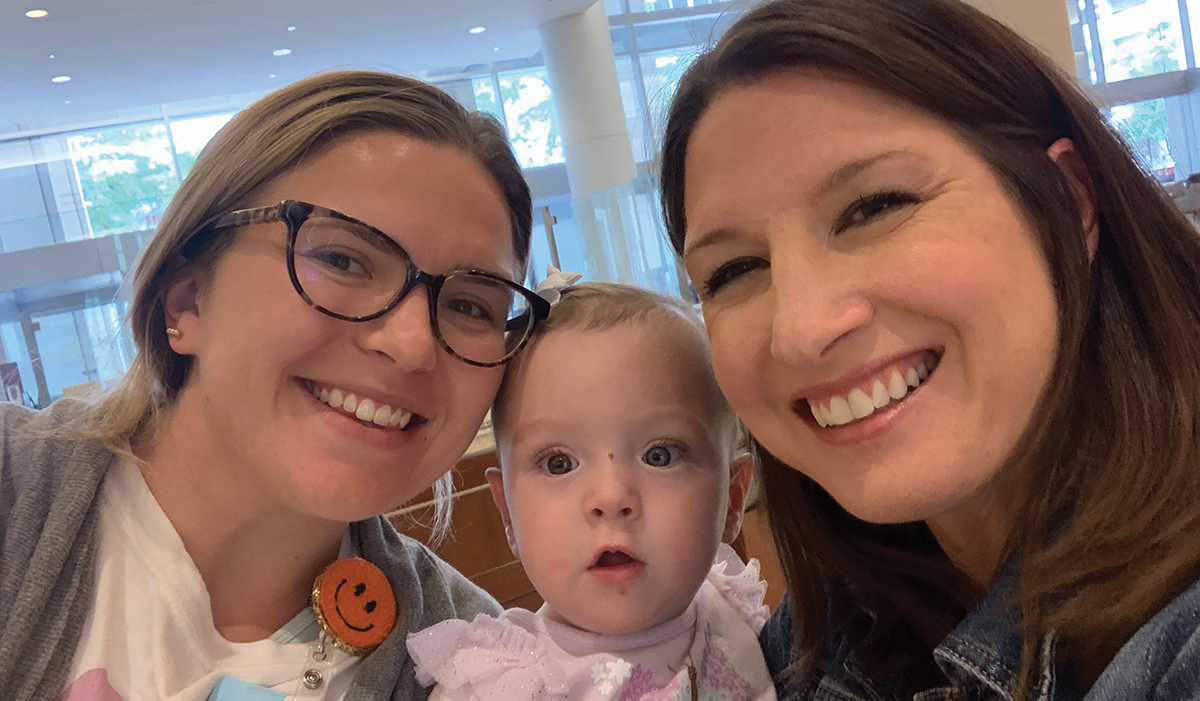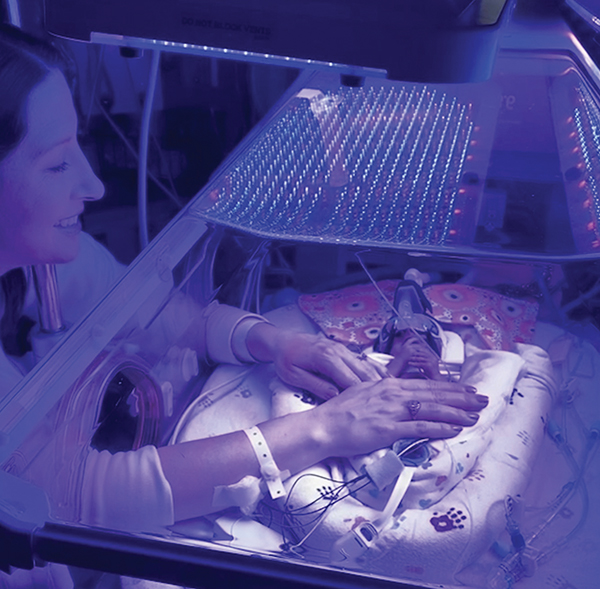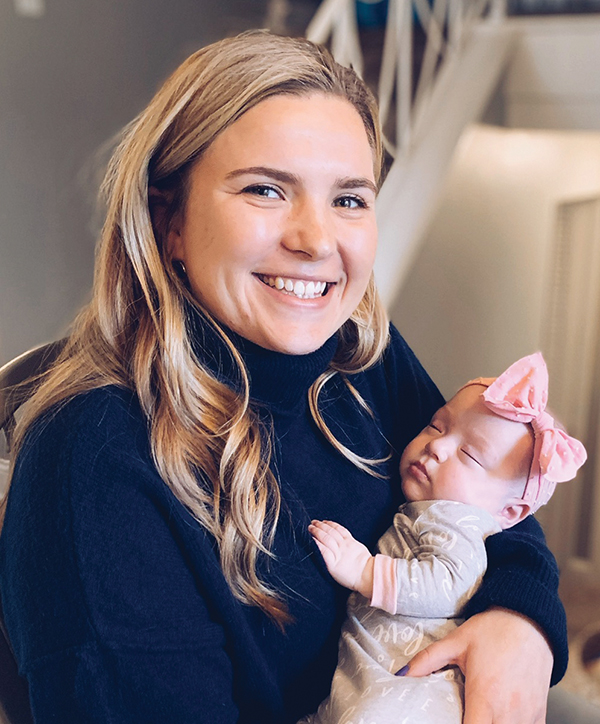Compassion in Crisis
By Elyse Paul '20

How Saint Mary’s values forged a lasting friendship in the NICU
In 2022, Mary Jo Dunne entered this world under circumstances no parent dreams of. At just 26 weeks pregnant, Mary Jo’s mom, Katie Boyce Dunne ’05, was admitted to Northwestern Medicine Prentice Women’s Hospital after her water broke. Katie found herself in a hospital room, filled with uncertainty. “I thought I would have to deliver right away,” she recalled, “but the doctors assured me that every day I could keep her in the womb was a victory.”
The following two weeks were a delicate balance of hope and fear. Each day that passed was another step closer to a safer birth. Then, at just 28 weeks in utero, Mary Jo arrived.
The baby was quickly placed in the hands of medical professionals who knew exactly what to do. Though nothing could have prepared Dunne for the difficulty of being separated from her daughter in those first critical days, each milestone in the Neonatal Intensive Care Unit (NICU) was a celebration, a reminder that there were victories in the smallest steps.
After just four days postpartum, Dunne went home.“Leaving the hospital without Mary Jo was perhaps the hardest moment of all,” Dunne says. “It felt entirely unnatural to walk out the doors, leaving behind my fragile newborn.” After the rollercoaster of emotions she’d felt leading up to the birth and since Mary Jo’s arrival, she couldn’t imagine how to navigate it all.
An Unexpected Friend

As the weeks went on, the hospital, once unsettling, began to feel like a second home. The nurses who cared for Mary Jo were no longer strangers. At first, Dunne knew them only as faces in a sea of people tending to her newborn, but with time, the connections grew, particularly with one nurse, Lainey Huth ’18, RN. Dunne’s husband Bill first made the connection that Huth graduated from the same college as his wife, after meeting her in the NICU. When he told his wife a fellow Belle was caring for Mary Jo, Dunne immediately felt at ease.
“It was like knowing, without even meeting her, that she would be compassionate,” Dunne said. “It’s a trait I’ve found in every Saint Mary’s woman—this deep-seated desire to make a difference in the world, to live out their values in whatever field they’ve chosen,” Dunne said. “That knowledge gave me comfort as a mother. It was more than just shared experiences; it was a deep trust in the type of person Saint Mary’s helps cultivate.”
Soon, Dunne met Huth in the NICU. “I felt an instant bond the first time I met her, as if her presence was an extension of home during such an isolating time,” Dunne said. She and Huth’s friendship and trust grew quickly. They shared conversations about their time at Saint Mary’s, and everything in between, making the long days in the NICU more bearable. As Mary Jo reached each milestone—coming off oxygen, her first bottle feed, each precious ounce of weight gained—Dunne and Huth celebrated together. The 97 days she spent in the NICU became a period of connection and reminiscence for her mother and her nurse.
On Mary Jo’s discharge day, the overwhelming feeling of gratitude was palpable. “I couldn’t help but think how remarkable it was to have strangers step into your life and care for your child as if she were their own,” Dunne said. “To have the care and connection be from a fellow Belle was simply beautiful.”
As an RN in the neonatal unit, Huth understands it is never an easy experience for parents or babies. With the Dunnes—and Mary Jo—the experience felt deeper than just caregiving. “She wasn’t just a patient; she became family. Sending Mary Jo home was bittersweet,” Huth said. “Yet, this experience wasn’t just about the care I provided—it was about the deep connection we shared, one that will last a lifetime.”
A Saint Mary’s Nurse is Unmistakable

Huth knew from a young age that she wanted to work with children. After a summer internship in the NICU as a nursing student at Saint Mary’s, she was hooked. “Pediatrics was where my heart was,” Huth said. “Working in the NICU has become a passion, especially working with vulnerable babies. It’s always a privilege to be part of these families’ lives during such difficult times.”
Growing up surrounded by infants and children, Huth always stepped in to care for her younger brothers or the cousins in her big family. “It was clear to everyone that I was drawn to nurturing others,” Huth shared. Her nurturing instincts and her Saint Mary’s education called her toward her vocation, and formed her into the nurse she is today.
Huth cites Cibele Webb, professor of nursing science, and Sister Maureen Grady, CSC, professor emerita of nursing science, as role models at Saint Mary’s who taught her not only the science of nursing but also the art of forming genuine connections with others. In particular, Sister Maureen’s communication sessions during Webb’s nursing leadership course showed Huth the importance of truly listening to patients.
“The values and skills instilled in me at Saint Mary’s —community, compassion, and a lifelong commitment to care—have made all the difference. I know that I am exactly where I am meant to be,”
- Lainey Huth ’18
It’s About Person-Centered Care
Webb and Sister Maureen have found a unique way to educate students in a required nursing leadership course at Saint Mary’s. Its focus goes beyond scientific and technical knowledge by including essential elements such as teamwork, collaboration, and person-centered care. They also emphasize a more holistic approach to nursing, one that relies on relational communication.

with her favorite nurse.
Using the TIS model—theme, invitation, and simplicity—Webb and Sister Maureen teach nursing students how to listen deeply to patients to understand the real theme of their concerns. In each session, students engage in role-playing exercises where they reenact conversations with patients, learning how to identify the core theme of the conversation, and respond with compassion. This method of teaching communication has become a staple in the nursing program. “There is nothing worse than sitting through a boring class or a boring presentation,” Sister Maureen says. “When students see the fire in the teacher, and they see how much you care about the subject—that’s inspiration.”
Webb explained how she weaves real-world stories into their classes. “For students, it’s not just about teaching a medical procedure; it’s about connecting facts to the lived experiences of patients. By sharing meaningful, sometimes funny or tragic stories about patients, they transform abstract medical knowledge into something relatable.” For students, who may get caught up in the technical aspects of care, these stories serve as a reminder that at the end of every procedure is a person who could be in pain.
Sister Maureen encourages students to reflect on their spirituality and their role as caregivers—not just through a lens of technical competence but as a ministry of care. This spiritual foundation helps Saint Mary’s nurses form a deeper connection with their patients and think more profoundly about their purpose as healthcare professionals.
Webb feels that the combination of spiritual depth and clinical expertise is what makes Saint Mary’s nurses exceptional. “This ability to blend expertise with empathy, to make the facts come alive through human connection, is where nursing education transforms from science into art,” Webb said.
This lesson certainly resonated with Huth, and its impact was felt by her new friend. The bond between them has extended far beyond the hospital walls. Continuing to watch Mary Jo thrive has become one of the most joyful and rewarding experiences of Huth’s career. She sees this enduring connection as a testament to the relationship-centered care that she learned as a young nursing student. It’s what makes the NICU, and the Saint Mary’s nursing program, one-of-a-kind.
What began as an unexpected friendship in the NICU has blossomed into a lasting relationship, one marked by shared victories and ongoing support. For Dunne, the journey from fear and uncertainty to hope and gratitude has been shaped not only by the resilience of her daughter but also by the unwavering care of a Saint Mary’s nurse who became family.
